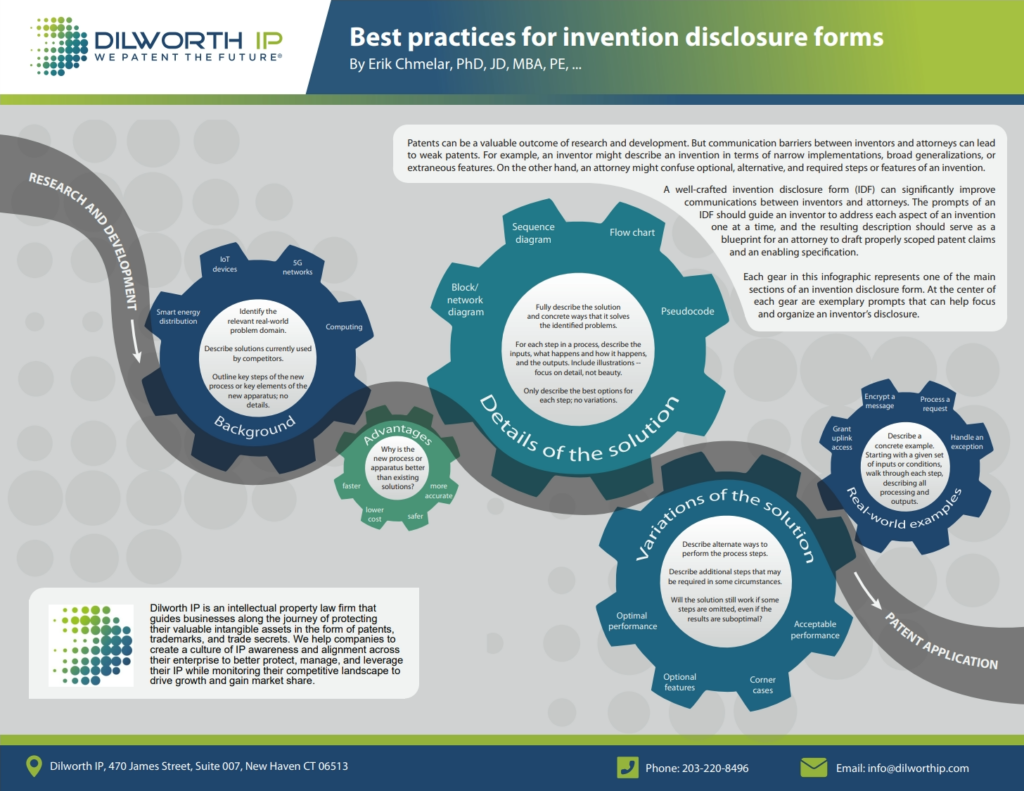Best Practices For Invention Disclosure Forms
May 24th, 2022 by Dilworth IP | News |
Leading companies tend to invest heavily in research and development (R&D). Typical R&D activities include researching ideas, building prototypes, and developing innovative products and services. But companies sometimes neglect a major component of R&D: the creation of intellectual property (IP) to protect innovations that arise from R&D activities. One reason is that R&D scientists and engineers can have difficulty communicating their innovations to IP attorneys responsible for protecting those innovations. Another reason is that IP attorneys sometimes lack the subject-matter expertise needed to appreciate certain technical nuances fully.
The four main types of intellectual property are patents, trademarks, copyrights, and trade secrets. Patents are the principal form of IP arising from R&D activities because patents protect inventions, and inventions come from innovation. In the United States, a patent is a right to exclude others from making, using, selling, and importing the patented invention. But getting a patent can be a complicated process that involves submitting a detailed disclosure of the invention to the US Patent and Trademark Office to be examined for “utility,” “novelty,” and “non-obviousness.”
While patent attorneys well understand utility, novelty, and non-obviousness, these concepts are less understood by scientists and engineers who create inventions. Yet, these inventors are expected to communicate their inventions in a manner that allows attorneys to draft patent applications that satisfy these requirements. This disconnect can result in patents that fail to fully protect and, perhaps worse, valuable inventions that never get patented.
An invention disclosure form (IDF) serves as a guide to help inventors communicate bibliographic and technical information about their inventions to attorneys. Bibliographic information includes things like who the inventors are, when and where the invention was created, and whether the invention has been publicly disclosed. Practically every IDF collects the same bibliographic information from the inventors. Because this information is relatively straightforward, it is not incorporated into the infographic and is not discussed further in this article.
Technical information includes things like what the problem being solved is, the key steps or features of the invention, and whether there are alternative solutions. This information varies based on industry, such as the semiconductor and pharmaceutical industries. Thus, it is good practice to customize an IDF for a particular industry. Further, the amount and quality of technical information that an inventor provides on an IDF depends greatly on whether the prompts of the IDF elicit focused responses. Generic prompts like “describe your invention” should be avoided.
Invention disclosure forms that follow several basic principles can greatly enhance communication between inventors and attorneys. This results in time savings for inventors and attorneys and, ultimately, stronger patents and fewer lost inventions.
The infographic highlights several important aspects of an effective IDF for software and computer-based inventions. First, an IDF should help organize the inventor’s thoughts. After all, inventors might be great at innovating, but there is no guarantee that they are also great at writing. At a minimum, an IDF should have narrowly tailored sections, such as the following:
- A “Background” section is where an inventor can describe the problem domain, existing solutions, and key steps or features of the invention that gives context for the following sections. Minimal details of the invention should be provided here.
- An “Advantages” section is where the inventor can explain why the new process or apparatus is better than existing solutions. Again, minimal details of the invention should be provided in this section—just enough to convey the advantages.
- A “Details of the Solution” section is usually the longest and most important section in the IDF because this is where the inventor provides the details necessary to practice the invention. This section is also difficult to write because it requires the inventor to describe specific implementations without constraining the invention to only those implementations. To achieve this goal, the inventor should be encouraged to use block diagrams, sequence diagrams, flow charts, and pseudocode. When used correctly, these tools can replace pages of dense and potentially difficult-to-understand text. Future articles will describe best practices for using several of these invaluable tools.
- A “Variations of the Solution” section is where the inventor can describe alternate or additional steps of a process or features of an apparatus and whether some steps or features can be omitted. The inventor should know those suboptimal variations are acceptable, especially if they are identified as such. In fact, suboptimal variations can help the drafting attorney determine which steps or features to include in the independent claims of an application and which to save for the dependent claims.
- Finally, a “Real-world Examples” section is where the inventor can provide at least one concrete example of how to practice the invention. For some inventions, this requires starting with a given set of inputs or conditions and walking through each step, describing the processing during each step and the resulting outputs.
Use this link to view and download the infographic:
This article is for informational purposes, is not intended to constitute legal advice, and may be considered advertising under applicable state laws. The opinions expressed in this article are those of the author only and are not necessarily shared by Dilworth IP, its other attorneys, agents, or staff, or its clients.



